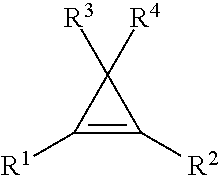Methods of treating crop plants
a crop plant and treatment method technology, applied in the field of crop plant treatment methods, can solve the problems of plant shock, large loss of quality and yield, and plant death, and achieve the effect of increasing the resistance of monocot plants and maintaining normal plant growth and development characteristics
- Summary
- Abstract
- Description
- Claims
- Application Information
AI Technical Summary
Benefits of technology
Problems solved by technology
Method used
Image
Examples
example 1
Soybean Plants
[0264]To prepare the tested composition, spray tank was filled with approximately two-thirds of the total volume of water required. The amount of Powder 1 or Powder 2 was weighed according to the rate and total volume of spray being prepared. The appropriate amount was calculated to give 1% v / v of total spray volume. Adjuvant 1 was added to the spray tank, which was agitated until the mixture turned milky white. Powder 1 or Powder 2 was added to the spray container, which was then gently (not vigorously) agitated. The remaining water was added, making sure all of the powder was wet and washed off of the sides of the tank (if any had deposited there). The spray tank was then swirled or stirred for at least two minutes (2-5 minutes) to ensure good mixing of the composition. Between 5 and 60 minutes thereafter, soybean plants were sprayed with the composition.
[0265]Flat fan nozzles were used to apply the tested composition to soybean plants, producing droplet size of 100 ...
example 2
Corn Plants
[0268]Corn of hybrid variety FR1064×LH185 was planted at 72,000 plants per hectare (ha), and treated as described in Example 1. Powder 1 was used. Treatment stage (i.e., developmental stage at which corn plants are treated with the disclosed composition), treatment amounts (grams of 1-MCP per hectare), and results were as follows. The simple measure of yield is reported as metric ton (mT) per hectare. Other measures of yield are also shown. Treatments lead to increase in yield by one or more measures.
DevelopmentStage(s)1-MCPat TimeDosageYieldKernelKernelProteinof Application(g / ha)(mT / ha)wt (mg)no.(1)%(2)Starch %(2)Oil %(2)Untreated(3)01.64248 4447.871.74.6V12101.80(4)266(4)4717.771.74.6V12251.84(4)270(4) 495(4)7.572.04.6VT101.86(4)267(4)4807.572.1(4)4.5VT251.87(4)277(4)4517.771.74.6R3101.81(4)265(4)4547.372.24.6R3251.82(4)265(4)4717.672.14.7V12, VT101.82(4)263(4)4597.671.94.5VT, R3101.72271(4)4377.771.64.8(4)V12, VT, R3101.70259 4647.2(4)72.4(4)4.6Notes:(1)number of...
example 3
Cotton Plants
[0269]Using methods similar to those of Example 1, cotton plants were also tested. Each treated group of cotton plants was treated either two or three times, as follows:
Treatment Time of FirstTime of SecondTime of ThirdTypeTreatmentTreatmentTreatmentPHS 2Soon after14 days after firstnoneappearance oftreatmentpinhead squaresPHS 3Soon after14 days after first28 days after firstappearance oftreatmenttreatmentpinhead squaresEB 2Soon after14 days after firstnoneappearance of treatmentearly bloomEB 3Soon after14 days after first 28 days after firstappearance of treatmenttreatmentearly bloom
[0270]The crop yield was assessed as the weight of lint per hectare. Treatment types, treatment amounts (grams of 1-MCP per hectare), and results were as follows. Many of the treatments lead to improvements in the yield of lint.
Dosage ofTreatmentLint Yield1-MCP (g / ha)Type(kg / ha)250PHS 2230.6250PHS 3231.8250EB 2245.3250EB 3250.2500PHS 2257.6500PHS 3262.0500EB 2234.2500EB 3261.31250PHS 2253.9...
PUM
 Login to View More
Login to View More Abstract
Description
Claims
Application Information
 Login to View More
Login to View More - R&D
- Intellectual Property
- Life Sciences
- Materials
- Tech Scout
- Unparalleled Data Quality
- Higher Quality Content
- 60% Fewer Hallucinations
Browse by: Latest US Patents, China's latest patents, Technical Efficacy Thesaurus, Application Domain, Technology Topic, Popular Technical Reports.
© 2025 PatSnap. All rights reserved.Legal|Privacy policy|Modern Slavery Act Transparency Statement|Sitemap|About US| Contact US: help@patsnap.com



